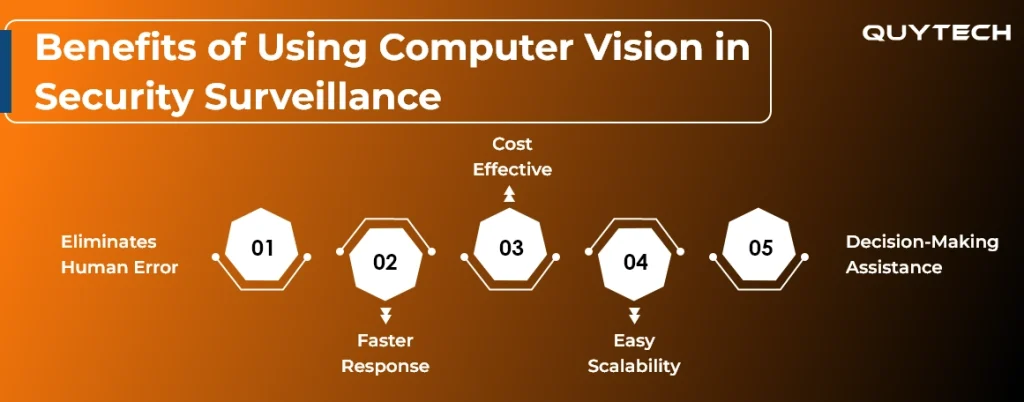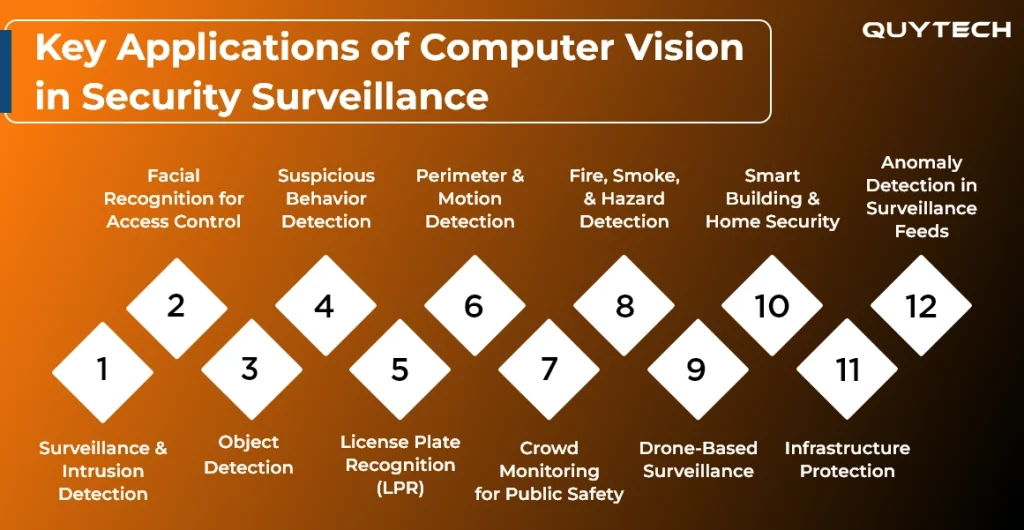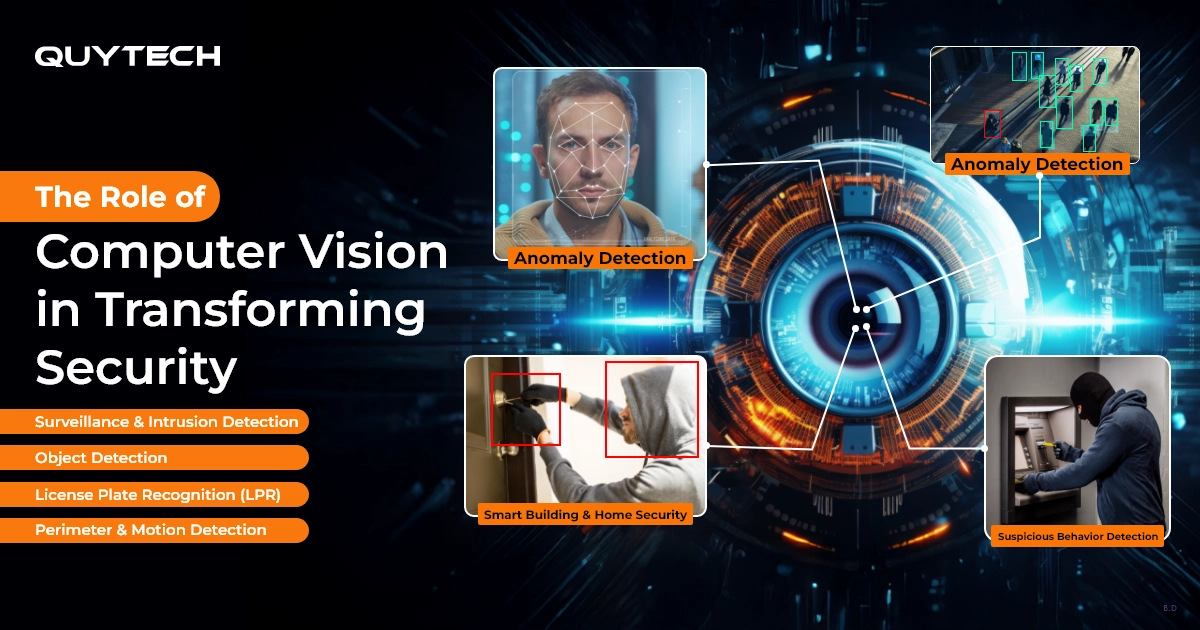Key Takeaways:
- Computer vision turns security from passive monitoring into proactive protection.
- It analyzes video in real time, understands events, and alerts instantly.
- It enables faster, accurate, and scalable security decisions in real time.
- In the future, computer vision is expected to be autonomous, ethical, and emotionally aware.
Security plays a very important role in every environment, be it a workplace or a manufacturing unit. And with threats rising to peaks, passive surveillance no longer meets the modern demands of security. This rise in threats and the lack of proper security systems create a need for a safer, more active surveillance system.
This is where computer vision enters the scene. With advanced capabilities like object detection, classification, behavior analysis, and much more, computer vision redefines the reactive approach of traditional surveillance. It analyzes video feeds in real-time, derives context, and takes proactive measures accordingly.
Sounds amazing, right? But there’s more to computer vision in security than this. Read this blog and explore everything from the working mechanism to the future trends of computer vision in security.
What is Computer Vision and How Does it Transform Security?
Computer vision is a technology that allows systems to see, interpret, and react to the incident taking place. In simple words, computer vision is the eyes and brain of smart surveillance.
The transformation that computer vision brings to security is that it’s no longer just a watchdog. In the traditional sense, security systems are effective only when security personnel monitor them. This meant that in the absence of supervision, any potential threat or incident happening would go unnoticed. But with computer vision in security, the tables are turned. Here’s how it brings transformation in security:
Real-Time Video Analysis
Unlike traditional video surveillance, computer vision acts in real-time. It does not require security personnel to sit and watch over multiple screens. Computer vision redefines security by not just capturing but also analyzing it in real-time. It doesn’t wait for human instructions to carry out analysis.
Object Detection and Classification
In conventional security surveillance, cameras simply record everything. They do not detect anomalies or incidents as they happen; they depend on human operators for this function. Computer vision can differentiate regular objects and anomalies without depending on human operators.
Smart Alerts
Computer vision goes beyond analysis; it acts. In traditional systems, each and every task is dependent on security personnel. With computer vision, no oversight is required. It can detect anomalies, and not just that, it can carry out safety measures like triggering alarms and notifying security personnel.
Uninterrupted Functionality
As we know already, traditional security is active as long as the personnel handling it are. If the person gets distracted or tired, events may be overlooked. Computer vision transforms this by working without breaks. Powered by artificial intelligence, smart surveillance does not get distracted, tired, or off work. It works 24/7 without compromising security.
How Computer Vision Works in Security Surveillance
Now that you know how computer vision brings transformation in security, you might be curious about the process it goes through for the same. So here’s a breakdown of how computer vision works in security surveillance:
Step 1: Visual Data Capture
The process begins when security cameras capture visual data like images, videos, etc. These feeds are the core elements to detect events and act on them. Once captured, the data is sent to the processing units.
Step 2: Real-Time Processing
In the processing units, the data captured is cleaned so that the result of the analysis is accurate. Processing is done because many times the footage captured may be impacted by the lighting and noise factors.
Step 3: Visual Data Analysis
After the footage is processed, the core step of data analysis takes place. It analyzes the processed feeds in real-time. It extracts the elements present and classifies them into objects, humans, vehicles, etc. This classification adds to the accuracy of the outcomes.
Step 4: Event Detection and Alerting
Once objects are classified, the next step focuses on figuring out the context of the visual data. With the help of AI-powered contextual awareness, computer vision interprets the event. Once it detects threats or anomalies, it sends alerts to the security personnel. When integrated with IoTs, computer vision becomes capable of triggering safety measures as well.
Step 5: Data Storage and Indexing
Computer vision is not limited to only visual data analysis; its process goes beyond this. It stores and indexes data for future reference and reviews. Storing also helps in decision-making processes, while indexing makes data retrieval and management easier.
Step 6: Continuous Learning Loop
Post all these steps comes the learning loop. Continuous learning loop adds the cherry on top by enhancing the quality of outputs. It does so by learning from each interaction it makes. Feedback also contributes to improving the quality of output given by computer vision in security.
Read More: Computer Vision Use Cases in Manufacturing: Explore Unique Applications for 2025
Benefits of Using Computer Vision in Security Surveillance
By now, you might’ve guessed how beneficial the implementation of computer vision in security is. It not only captures threats but also reacts to them. Computer vision in security surveillance follows a proactive approach that benefits organizations in preventing losses and accidents effectively. Let’s dive deeper into the benefits of using computer vision in security:

Eliminates Human Error
In traditional surveillance, human operators are in charge of security. Due to fatigue, boredom, or related reasons, they might lose focus or make errors. These human errors can cost more than monetary loss to organizations.
With computer vision in security and surveillance, human error is eliminated. It analyzes collected visual data, runs multiple checks to ensure accuracy, and then offers the output. This eliminates not just human error but also false positives.
Faster Response
The speed of response in computer vision-based security systems is way faster than traditional ones. The conventional systems take a lot of time to respond to an incident. This is because security personnel have to go through numerous video feeds to flag a certain incident.
However, computer vision in security and surveillance analyzes video feeds in real-time. Not just that, it can also alert security personnel to notify them and activate safety responses, like triggering fire alarms in emergencies.
Cost-Effective
Implementing computer vision in security cameras comes out as a cost-effective solution. In the traditional setting, video surveillance requires a team to handle. Not just this, it still fails to deliver quality, which can often lead to loss from threats like theft, fire, vandalism, etc.
Computer vision eliminates the need for a huge team to handle surveillance systems. Along with this, its accuracy in delivering results saves organizations from monetary and related losses.
Easy Scalability
If we view scalability from the conventional perspective, scalability is quite costly. It is more about increasing the number of security staff, which naturally adds to the costs. Not just staff, but equipment needs also increase when opting for scalability in traditional security systems.
But with computer vision, scalability becomes as easy as breathing. Since smart surveillance is not dependent on human operators, scaling doesn’t need more security staff for supervision. Computer vision is capable of handling more cameras without a heavy investment.
Decision-Making Assistance
Computer vision in security makes the process of decision-making more efficient. Unlike traditional surveillance, where decisions were made based on assumptions and experience, computer vision backs the process with data-driven insights.
It offers data-based recommendations for actions and decision-making processes. And unlike conventional security, computer vision does not take weeks to do so; it does it within seconds.
Similar Read: How AI is used for Computer Vision and Image Recognition?
Key Applications of Computer Vision in Security Surveillance
Now that you are familiar with the concept, working mechanism, and benefits of computer vision in security, let’s walk you through its key applications. Computer vision contributes to security surveillance in ways that go beyond basic supervision. Here’s a list of areas where computer vision is used in security:

Surveillance and Intrusion Detection
The most obvious and common application of computer vision in security is surveillance. It helps in monitoring areas and flagging intrusions to prevent mishaps and similar threats beforehand.
Facial Recognition for Access Control
For organizations and areas that are restricted to certain people, computer vision offers facial recognition features. This helps in controlling the access of people to premises. It does not need much hassle; access is granted by recognizing faces.
Object Detection
Another area where computer vision is applied in security is object detection. It can spot, classify, and detect objects accurately. This helps in identifying unusual objects like bags in open areas, vehicles, and weapons.
Suspicious Behavior Detection
Computer vision in security is also capable of detecting suspicious behavior. It can detect abnormal activities like loitering, panic movements, violent activities, tampering, etc., in real-time.
License Plate Recognition (LPR)
License plate recognition, powered by computer vision, helps in reading number plates in real-time. This is usually utilized in parking lots, tolls, stolen vehicle tracking, and traffic management.
Perimeter and Motion Detection
Computer vision is used for perimeter and motion detection. This helps in protecting properties from intrusion, as computer vision alerts security personnel if an intruder crosses the boundaries of the concerned property.
Crowd Monitoring for Public Safety
Computer vision in security cameras contributes to public safety by monitoring crowds. It manages crowds by counting the number of people, ensuring public safety at events. Along with this, it also helps in preventing panic movements during emergencies.
Fire, Smoke, and Hazard Detection
Unlike conventional sensors that detect fire hazards after they reach a certain point, computer vision detects them in real-time. It can detect these hazards as they appear and can even trigger safety measures to prevent them from getting out of hand.
Drone-Based Surveillance
Drone-based surveillance makes use of computer vision and AI technologies to capture areas that are otherwise inaccessible. It is an aerial surveillance system that can reach areas like borders, forests, etc., where you can’t establish camera-based surveillance.
Smart Building and Home Security
Computer vision in smart buildings and home security helps residents in reacting to threats timely manner. It contributes to adding safety to residential areas, protecting them from intrusion threats.
Infrastructure Protection
Another application of computer vision in security is infrastructure protection. It helps in protecting public infrastructures like power plants, roads, bridges, etc. Computer vision eliminates the need for allocating staff to monitor multiple screens.
Anomaly Detection in Surveillance Feeds
Anomaly detection refers to detecting unusual and suspicious activities. Computer vision applied to surveillance feeds assists in detecting anomalies without depending on human operators. It does so by comparing the event with normal events and taking safety measures accordingly.
You Might Also Like: How AI Video Analytics is Disrupting Traditional CCTV Monitoring
Challenges and Best Practices for Implementing Computer Vision Security
While computer vision in security brings a lot of benefits, its implementation brings its own set of challenges and concerns. To ensure that your implementation process goes smoothly, here are some challenges to look out for, along with the best practices:
Data Privacy Concerns
As is obvious, computer vision collects facial data and activity. This can be a challenge when implementing, as people might have privacy concerns. And since it is handled digitally, cyber threats might also add to the worry.
Best Practices
To ensure that no data is exposed to unauthorized personnel, organizations can follow data encryption practices. Maintain transparency about the data being collected, how it’ll be utilized, and stored.
High Implementation Costs
Implementing computer vision in security can be quite expensive in the initial stages. The cost of implementation is what often ends up binding the hands of organizations opting for it.
Best Practices
In such a case, organizations can opt for cloud-based computer vision solutions. Along with this, opting for pre-trained models can also help in reducing the costs associated with implementing computer vision in security.
System Integration Challenges
As mentioned already, computer vision is not just integrated with the cameras but also with alarm systems, IoT devices, etc. This integration makes computer vision capable of taking safety measures in time. Outdated systems might make this integration hard or unsuccessful.
Best Practices
For a seamless integration experience, organizations can opt for API-based integration methods. Along with this, they can also follow gradual integration practices.
Environmental Challenges
Environmental challenges are yet another set of hurdles that might impact the computer vision solution, even after implementation. This is because, many times, the hardware (cameras) are not able to clearly represent the real-time situations. Weather and lighting are the major causes here.
Best Practices
To ensure that you do not face these challenges, opt for infrared and thermal surveillance cameras. This will ensure that your cameras work even in low-light conditions.
You Might Also Like: An Ultimate Guide to Video Analytics: Applications and Opportunities
Future of Computer Vision in Security Surveillance
With increased inclination towards technology, computer vision in security surveillance is also expected to capture a bigger market. Being an artificial intelligence-based technology, it is likely to integrate with more such technologies, adding to its feature set. Here are some of them:
Integration with Agentic AI
In the future, computer vision in security is expected to adopt autonomous working. This will be made possible by integration with agentic AI. With this integration, the level of automation will increase along with increased autonomy.
Advanced Emotion and Behavior Analytics
With behavior analytics already being a part of computer vision, the future holds advanced emotion detection for smart security. This will make computer vision capable of detecting the intent of a person from their emotions and expressions.
Ethical AI
As doubts about data privacy surface, computer vision is expected to adopt ethical AI practices in the future. This will ensure that all the data collected through cameras and sensors stays safe. It will prevent misuse of data and foster ethical use of AI technologies.
How Quytech Helps in Developing Computer Vision Security Solutions
Quytech excels in developing computer vision security solutions. Our 14+ years of experience in catering to different industries reflect our commitment to developing tailored computer vision solutions. Our team of dedicated developers pools in their knowledge and expertise in the field of computer vision to create robust security solutions.
Our computer vision projects, like AI car detection, AI-powered fall detection, and suspicious behavior detection, reflect our ability to develop adaptable solutions. With cloud-based access control and indexing features, our smart surveillance solutions bring convenience to data storage and retrieval processes.
Conclusion
As the need for advanced and smart surveillance arises, computer vision-based solutions are capturing the market. With features like real-time video analysis, object detection and classification, smart alerts, and 24/7 working, computer vision has given traditional surveillance a makeover.
Transforming the slow, time-consuming, and error-prone surveillance methods, computer vision brings speed and accuracy to security. With advantages like cost-effectiveness, easy scalability, and decision-making assistance, computer vision in security overcomes its implementation challenges with the benefits it provides.
FAQs
Traditional CCTV monitoring requires human operators to supervise, whereas computer vision can itself analyze and look out for threats without human intervention.
Yes, when integrated with infrared cameras, computer vision can accurately function even in low-light or complex environments.
No, computer vision does not replace the need for human security teams. Instead, it makes their work easier by eliminating the tasks of monitoring camera feeds.
The implementation costs of computer vision in security depend on the complexity, deployment type, and use case of the solution.


